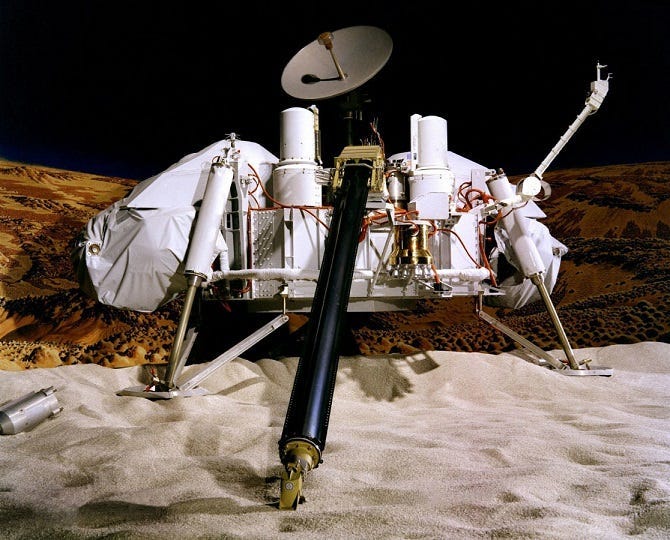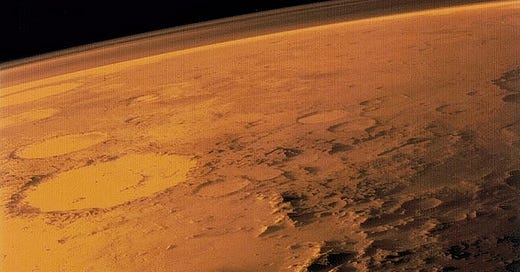Not Only Did Mars Have An Ocean, But A Tsunami So Large It Defies Description
Ancient history uncovered by modern probes far from Earth

The word “history” by its own nature gives us a sort of bias. Herodotus, in the fifth century BC, is thought to have coined the term itself. According to author Edith Hamilton in her book The Greek Way, “history” in its Greek base means “to investigate.”
Herodotus did just this by traveling the ancient world as far as possible, experiencing, and seeing things himself. Then, noting what he saw. Often when his eyes weren’t enough, he relied on stories from eyewitnesses or people living in a region.
But history stretches beyond eyewitnesses, or even the human age itself.
Often nature and the universe create their own history, in a far more fantastic way than humanity could ever dream. Such an event is unfolding before us today. But its eyewitnesses aren’t human, in this case, they’re rocks and sediment.
In an even more fantastic turn, these nonliving witnesses aren’t even on our planet. They reside on Mars. And they have one of the most fantastic stories in the universe to tell us.
According to a recent scientific analysis, not only did Mars have an ocean 3.4 billion years ago, but suffered a cataclysmic asteroid strike in that body of water. The impact created a wave as tall as a skyscraper. Furthermore, the flow of water left scars on the landscape with us to this very day.
But to start our present story, we need to travel back about fifty years to the age of Viking. Not the seafarers, but the space probe on its way to Mars.
A Viking’s View Of Mars
According to NASA’s Jet Propulsion Laboratory (JPL), the Viking 1’s lander was the first space craft to successfully land on Mars. It came equipped with an array of scientific tools in 1976.
Imaging systems, infrared thermal mappers, spectrometers, seismometers, and a robotic arm went to work for six years. Despite the effort, they found no life. However, the Mars experienced through investigation was much different than expected. According to JPL:
“Viking 1 did help better characterize Mars as a cold planet with volcanic soil, a thin, dry carbon dioxide atmosphere and striking evidence for ancient riverbeds and vast flooding.”
In their research paper in Scientific Reports, Dr. Alexis P. Rodriguez and his team found Viking landed near the end of “an enormous catastrophic flood channel.” However, something was off. It didn’t show certain telltale signs expected with a massive flood.
Its cameras captured boulders tossed all about the region.
After searching some Mars surface maps, the team identified an impact crater, called Pohl, about sixty-eight miles wide, nearly five hundred fifty miles away.
Due to the position of the crater, and the direction of the channels, the team believes the Pohl impact is responsible for the movement of rock and sediment.
But unlike Herodotus, Rodriguez and his team had computers, which could interview the nonliving witnesses of the event. The rocks and sediment didn’t disappoint. They indicate something truly spectacular happened about 3.4 billion years ago after the Pohl impact.
Strangely, Rodriguez and his team also believed it occurred within an ocean.
A Martian Ocean
NASA’s Goddard Space Flight Center used three of the world’s largest infrared telescopes to study Mars. Planetary scientists Geronimo Villanueva and Michael Mumma explain they were able to capture the whole hemisphere and make maps of the planet. But not of geography.
They mapped water, in particular, heavy water.
This water in highly enriched form, is frozen within Mars’ polar region. But it’s more than a modern find. The heavy water enabled the NASA scientists to roll back the clock and see how much water Mars lost over the years.
They estimated only thirteen percent of Mars’ water remains.
After some calculations, the planetary scientists figured twenty percent of Mars’ entire surface was covered with water. They believe it would have settled over the lower northern plains. NASA even has an idea of what it looked like at the time.

Interestingly, the scientists also note this ocean likely existed about four and a half billion years ago, and slowly evaporated. So, it’s within the timeframe of the Pohl impact.
A Martian Mega Tsunami
Rodriguez and his team fed several scenarios into computer simulations, trying to recreate the Martian landscape around Viking 1. Eventually, two worked. These involved the impact dislodging massive amounts of the seafloor, which were carried within the water.
According to the models, an asteroid from two to six miles wide struck the surface, unleashing over five hundred thousand megatons of TNT energy. For perspective, the largest nuclear weapon ever detonated by the United States military was fifteen megatons. However, this is only a small piece.
The team believes the impact occurred within the ocean, unleashing a tsunami of epic proportions. According to their simulations, a massive wave occurred. This reached a total height of five hundred meters, which equates to over sixteen hundred feet.
Again, for perspective, this is the height of the second largest building in the world, the Shanghai World Financial Center.

This wave eventually “propagated to ~ 250 m above sea level, overrunning the V1L site.” So, the rush of water traveled over five hundred miles. Eventually resting, with debris, around Viking’s landing location.
Oddly, they also point out if the planet had red dust, like it does today, the ocean would have been tinted red by the particles.
Rodriguez and his team compare the event to the Chicxulub impact on earth, which occurred in a marine environment and created similar mega tsunamis in simulations, which are believed to have wiped out the dinosaurs.
This type of event wasn’t unheard of on Earth either. Like Mars, it wears scars on its surface from massive movements of water.
The Younger Dryas Impact Theory posits that a meteor hit Earth about thirteen thousand years ago, causing massive flooding and the extinction of mega fauna and the Clovis culture. Not to mention a quick warming cycle within a hundred years that ended an ice age.
According the Zanclean Mega Flood Theory, the Mediterranean Sea was filled within two years, after the Atlantic Ocean broke through a natural barrier.
And since we’ve traveled back to Earth, it’s time for us to consult with Herodotus once more.
History Isn’t Limited To Humanity
Twenty-five hundred years ago Herodotus created a new form of literature: history. He focused on truth, as opposed to fiction and opinion. While he got things wrong, he tried to stick to facts as best as he could.
So, he relied on his eyes, and words of locals familiar with events.
In our new world of technology and computers, they have become a new form of eyes. They enable us to travel into space. Plus, peer back in time billions of years within the past, long before life formed on our planet.
Likewise, our new tools enable us to turn rocks and sediment into eyewitnesses, telling amazing stories of events long past.

While most will consider it science, I still consider it part of history. As Herodotus “investigated,” so do we. Our new abilities just allow us to transform history beyond the scope of what the ancient Greek thought possible.
We’re now not only limited to the story of people, but the tale of a massive crimson tsunami which took place on a planet far from ours, billions of years ago.
-Originally posted on Medium 12/5/22


